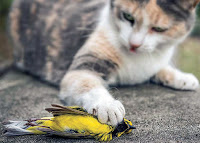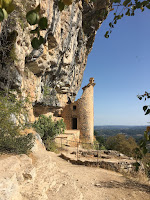Before my emancipation from the working life I tried to
spend most of the month of August at Bigadore. In August the mosquitoes have
subsided, the water temperature has warmed nicely in the saltwater swimming
hole below the cabin, there is still plenty of sunshine to savour. August was
good for birding too: the woodland breeding birds were still here, and as the
month progressed I could look forward to ‘fallouts’ of early migrants: small
gangs of warblers and sparrows of several species gathered in a feeding flock
in my birches, pin cherries and mountain-ashes.
The halcyon days are gone. I used to see swallows from the
cabin at Big Bras d’Or: barn swallows, tree swallows, perhaps an occasional
cliff or bank swallow. The swallows have pretty much passed out of view here at
Bigadore. I have been here since the first of June—close to four months—and have
not seen a single swallow. Not one.
Nowadays there is no way a keen birder could routinely find
two dozen species here, let alone forty. These days I walk my trails and woods
and encounter mostly silence. If not for squirrels inclined to object to my
passage the woods might be perfectly still. Rather than a couple of dozen
species on a morning walk, I might find five, or four, or three.
This past week news headlines informed us of a scientific
study cataloguing the precipitous decline in woodland birds. The report was no
surprise to me: I have been seeing it with my own eyes for years, but this year
in particular has been shocking. I still see waterbirds: gulls, gannets in
their season, passing herons at dusk, groups of scoters assembling for autumn on
the Great Bras d’Or. But songbirds—warblers, swallows, sparrows—are another
matter entirely.
The precipitous decline in songbird numbers is a sad fact
that can be laid largely at the feet of humans. We destroy bird habitat. We
build skyscrapers, telecommunication towers and wind generators without much
concern for the migrating ten or twelve-gram birds that crash into them during
their night-time migrations. We allow our beloved cats to go outside where they
do what nature designed them to do: hunt and kill. Twice this summer I have
been seated on a friend’s veranda when the family cat triumphantly returned
home with a bird in its teeth. The experts tell us that millions of birds are
slaughtered every year in North America by cats allowed to do as they will in
the great outdoors.
It is not just cats. I recall how appalled I was to learn
about the toll delivered by a single telecom tower in Pennsylvania some years
ago: more than a thousand ovenbirds killed on one night—just one—as a
consequence of flying into an unseen tower in the dead of night.
What can be done? I am gratified to hear that initiatives
are under way to give birds warning as they approach tall structures. Good. We
can help as individuals too. Windows are bird-killers. A big picture window is
a joy to the folks indoors enjoying the view outside. It is something else to a
bird that crashes into it. People who care can help remedy the problem by
placing silhouettes in their window—perhaps of a falcon or hawk—to signal that
the window is something a bird should avoid.
For a person who is both a cat-owner and someone who agrees
that the world is a better place with wild birds in it, does it not make sense, for the welfare of birds and for its own sake, that Puss enjoys life in
the safe and secure comfort of its own home?


























